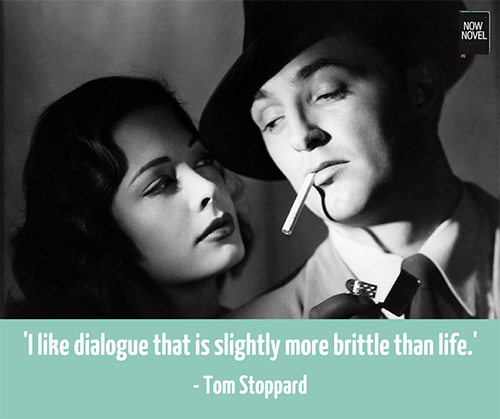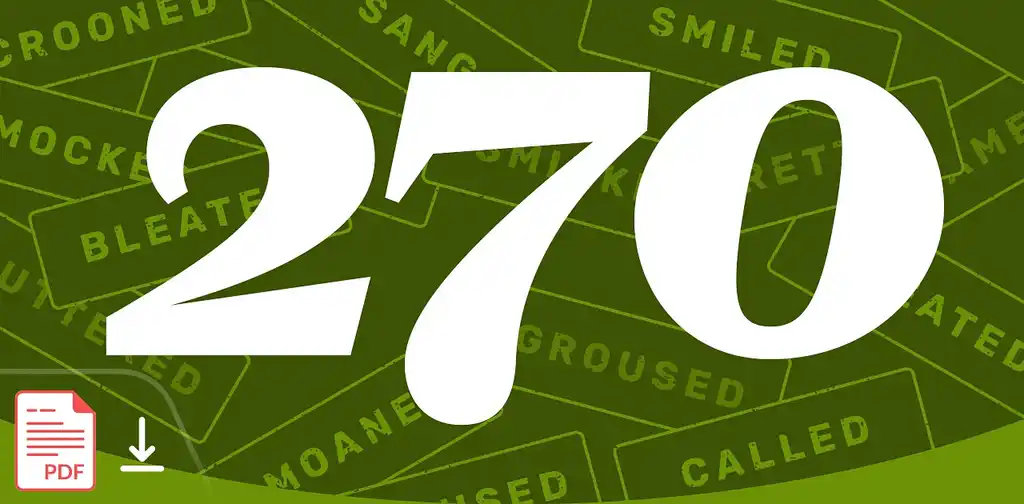Dialogue is a key part of any character-driven novel. What characters say and how/why/when/where they say it is revealing. Read 5 types of dialogue your novel needs, and illustrative examples from books:
1: Dialogue introducing key characters
Dialogue is useful for introducing characters because:
- It allows subtlety. We can show crucial details of characters' personalities without explicitly stating them in narration
- It moves quicker. Dialogue is nimbler than paragraphs of narration
- Characters' voices gain immediacy. We meet characters through their own voices
Take this example from Margaret Atwood's The Handmaid's Tale (1985). The dystopian novel about a near-future world where women are enslaved for reproductive purposes, is narrated by one such woman, Offred.
Here, we first meet Cora who works in the kitchen at Offred's residence. Offred describes eavesdropping:
Sometimes I listen outside closed doors, a thing I never would have done in the time before [...] Once, though, I heard Rita say to Cora that she wouldn't debase herself like that.
'Nobody asking you,' Cora said. 'Anyways, what could you do, supposing?'
Margaret Atwood, The Handmaid's Tale (1985).
'Go to the Colonies,' Rita said. 'They have the choice.'
'With the Unwomen, and starve to death and Lord knows what all?' said Cora. 'Catch You.'
Cora's voice is grimly practical. [Note: Atwood leaves out speech marks in her original text.] Cora is quick to shoot down Rita's dream of greater freedom.
Further dialogue hints more at women's constrained options in Atwood's world:
'Anyways, they're doing it for us all,' said Cora, 'or so they say. If I hadn't of got my tubes tied, it could have been me, say I was ten years younger. It's not that bad. It's not what you'd call hard work.'
Through this dialogue, we learn useful things about Cora as well as Atwood's world:
- Cora sides with dominant power, discouraging others from challenging it.
- Atwood's dialogue gives us information about women's limited options in her world. Cora's words imply that surgical sterilization is one of the only alternatives to more sacrificial choices.
Similarly, introduce characters' personalities alongside pivotal information about your world and its main features. Atwood uses overheard conversation to communicate a key issue for her characters (reproductive rights in a gender-biased regime). [Writing memorable characters also means understanding backstory, balancing plot with character, and more. Get help with these elements via our workbook, 'How to Write Real Characters'.]

2: Dialogue showing important conflicts between characters
Conflict in stories shows characters' conflicting wants and needs and builds narrative tension. Even minor clashes or disagreements between characters are often revealing about their individual views, values, and goals.
Dialogue helps story conflicts because:
- It moves faster than narrative prose, creating in-the-moment drama
- It makes characters' relationships believable - even the most steadfast friends and lovers, after all, have their squabbles
Let's examine an example of conflict-creating dialogue by Toni Morrison. This example, from her novel Song of Solomon (1977), is revealing of her characters Macon Dead and his sister Pilate, and their key differences:
Finally he had told her not to come again until she could show some respect for herself. Could get a real job instead of running a wine house.
"Why can't you dress like a woman?" He was standing by the stove. "What's that sailor's cap doing on your head? Don't you have stockings? What are you trying to make me look like in this town?" [...]
Pilate had sat there listening to him, her wondering eyes resting on his face. Then she said, "I been worried sick about you too, Macon."
Exasperated, he had gone to the kitchen door. "Go 'head, Pilate. Go on now. I'm on the thin side of evil and trying not to break through."
Toni Morrison, Song of Solomon (1977).
Morrison masterfully weaves succinct narration with physical description and gestures such as Macon ushering Pilate out. Note how Macon bombards his sister with accusing questions. Together, they are revealing of his character, his preoccupation with status and public perception. Also note how Pilate doesn't address his questions directly. Instead, the two speak at cross purposes.
Pilate, not answering her brother's angry questions, addresses the lack of care and respect in Macon's tone. His final gesture of throwing her out complements the dialogue. The dialogue, in this case, does nothing to diffuse or resolve the tension. It thus is a conflict that builds to further, decisive action that results in an enduring rift between the siblings.
Morrison's dialogue conveys conflict through:
- Characters' tone: Mason's tone is angry, accusatory. Pilate's is disappointed and also suggests how she believes Macon should be feeling - concerned for her well-being
- Characters' positions and movements: The fact Macon stays near the stove creates a sense of physical distance between the siblings. His shoeing Pilate out the door breaks the verbal and spatial stand-off
There are further types of dialogue that are important in novels of all genres:
3. Dialogue for telling characters apart
Of the various types of dialogue, dialogue that illustrates characters' core differences is useful for characterizing your story's cast. Besides characters' voices, their personalities, beliefs and world views will ideally become clearer, through dialogue, over time.
Differences between characters in dialogue create dramatic contrast. When dialogue illustrates characters' mutual differences well, their decisions and reactions to situations feel believable, based on what we already know.
Although an older example, George Eliot's characters are so clearly different from each other their dialogue is worth exploring.
In her classic novel Middlemarch, Eliot makes sisters Celia and Dorothea different right from the start of the book. For example, when the sisters discuss jewelry left to them by their late mother:
Celia was trying not to smile with pleasure. "O Dodo, you must keep the cross yourself."
"No, no, dear, no," said Dorothea, putting up her hand with careless deprecation."
"Yes, indeed you must; it would suit you - in your black dress, now," said Celia, insistingly. "You might wear that."
George Eliot, Middlemarch (1871-1872).
"Not for the world, not for the world. A cross is the last thing I would wear as a trinket." Dorothea shuddered slightly.
"Then you will think it wicked in me to wear it," said Celia, uneasily.
"No, dear, no," said Dorothea, stroking her sister's cheek.
Celia, the more worldly, slightly more vain sister, brings up sharing the jewelery. She focuses on aesthetics, how it will look. Dorothea, on the other hand, thinks about 'rightness' or 'wrongness', about what is 'correct' to wear and what is not.
Dorothea, who shudders at the idea of wearing a cross, is more pious and idealistic. From the start, we also see the dynamic between the sisters in dialogue. Celia defers to her older sister's judgment. It's clear that Celia needs approval from Dorothea, and flinches at being the target of her strict moral standards.
In her dialogue, Eliot shows her characters' differences using:
- Tone: Celia comes across as more tempestuous in nature. She flits between pleasure and unease, cajoling her sister one second and anxiously worrying about her disapproval the next. By contrast, Dorothea's reactions are softer. Her shudder is 'slight', and her gesture of stroking her sister's cheek to reassure has a similar softness.
- Word choice: Celia's language is more commanding. 'You must' she says, and 'now'. Dorothea's personality is shown as gentler and easygoing, even slightly patronizing. She repeats herself ('no, no, dear, no').
- Gestures: Celia trying not to smile suggests a character who is very conscious of herself. Dorothea on the other hand is less self-conscious in her gestures.
Although not technically 'dialogue' in the sense of a conversation between characters, 'inner dialogue' is also a useful type of dialogue in fiction:

4: Dialogue for showing characters' inner conflicts
Internal or inner dialogue (or rather 'inner monologue' - the conversation a character has with themselves) is not necessary in every story.
Yet in novels where characters must deal with inner or internal conflict, it's an effective device. Instead of writing 'Jean couldn't decide whether to hide the gun in her backyard or drive out to the woods,' for example, you could write:
Should I bury it? She cast an eye around the scrappy yard, searching for the least obtrusive spot. Then again, the woods are wild and overgrown now, and quiet this time of year... She rushed to the garage. Was about to turn the key in the ignition when an awful thought occurred.
Setting apart characters' thoughts, in an ongoing conversation with themselves, becomes distracting if overused. Yet in a scene of high inner conflict, a little private self-talk is useful for showing a character pushed and pulled by different ideas or inclinations.
Dialogue is also crucial for information-seeking character arcs. For example, in novels involving investigations - detective and mystery novels and their various sub-genres:
5: Revelatory dialogue
Dialogue in which a character is attempting to find out key information is useful for developing your plot. In detective novels or murder mysteries, dialogue that mystifies or perplexes adds tension and suspense. We want to know the significance of this fact or that utterance.
Let's examine a brief example by the acclaimed Canadian mystery author, Louise Penny. In the second novel from her Three Pines Mysteries series, A Fatal Grace (2007), Chief Inspector Armand Gamache discusses unsolved cases with his wife, Reine-Marie:
'I'm sorry, Armand. It's just that I knew this woman.'
Louise Penny, A Fatal Grace (2007).
'No.' Gamache set his own dossier aside and came beside Reine-Marie. 'How? What's the case?'
'She wasn't a friend or anything. You probably knew her too. That bag lady down by the Berri bus station. You know, the one with all the layers in all weather. She'd been there for years.'
Gamache nodded. 'Still, it can't be considered an unsolved case yet. You say she's only been dead a few days?'
'She was killed on the twenty-second. And this is strange. She wasn't at the Berri bus station. She was over on de la Montagne, by Ogilvy's. That's a good, what? Ten, fifteen blocks away.'
Here, Penny uses revelatory dialogue to provide as well as conceal important facts. We know a vagrant woman was killed. We know the location of her usual station, and when she was killed. Yet there are also mystifying pieces of information, such as the fact the woman was in an unlikely place when she was murdered. It's thus apparent that there's an untold story behind what the woman was doing so far from her usual haunt.
In writing revelatory dialogue, it's important to have a sense of where your story is heading. That way, you can drop clues that fit into your arc. If, for example, you were Penny and had already decided the woman was lured to de la Montage under the false pretense of a job offer, you could drop further clues to this end in following scenes.
Different types of dialogue have different purposes, yet in the end they all lead back to character. Great written dialogue makes characters and their actions all the more believable. We hear their strengths or faults, desires or fears, their certainty and wonder in their voices.
Want to improve your dialogue? Book your place in the next session of our comprehensive 4-week course, 'How to Write Dialogue', now.










Excellent advice and examples.
Jill - Almost 3 years ago